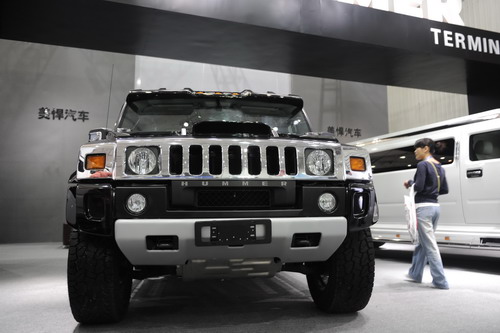US
US-built cars lose way in China
By Wang Chao (China Daily)
Updated: 2010-09-20 10:53
 |
Large Medium Small |
|
 A Hummer, on display at the 2009 Chengdu Motor Show in this file photo, is now a "cool souvenir" for some wealthy Chinese. Wang Xiwei / for China Daily |
BEIJING - Hummer production in the United States has ended, but that has had one unlikely reaction in China - an increasing demand for the SUV which some say is big, brash and ugly.
The last Hummer H2 available in Beijing, for example, was sold for 1.6 million yuan ($236,000), more than 300,000 yuan higher than its sticker price of 1.28 million yuan.
"We still have potential buyers for Hummers," said Gong Jianzhong, from Yayuncun Automobile Exchange Center in Beijing, the biggest auto market in northern China. "People are still coming in, asking for Hummers."
But this demand may be attributed to wealthy Chinese such as coal mine owners from Shanxi and Inner Mongolia want the vehicle as a "cool souvenir" before the nameplate disappears, Gong said.
Other American marques are also not doing well in China, the world's largest auto market in terms of sales and production.
Although many US manufacturers have joint ventures with Chinese auto companies, sales of American-made cars began to decline in 2007, Cui Dongshu, secretary-general of the China Automobile Dealers Association market research branch, said.
"It never picked up the momentum again," Cui said.
The association said that in the first half of this year, China imported 169,603 cars, with a year-on-year increase of 126 percent, the highest during the last decade. Only 7,000 of these came from the US, about 4 percent of the numbers imported.
Imports from Germany made up 63 percent, and Japanese cars 24 percent.
In many Chinese customers' minds, American car brands are "huge" and "gas consuming", and have "exaggerated designs" and "high cost".
Even in the US, these cars cannot compete with Japanese cars. Among the 10 bestsellers last year, six came from Japan, with the Toyota Camry topping the list. Three years ago, Toyota overtook Chevrolet to become the top-selling marque in the US.
In China, driven by the government policy that encourages smaller-engined cars, cars with engine capacities of under 3 liters are more popular.
In the first half of this year, imports of cars with engine capacities of under 3 liters increased by 113 percent compared with the same period last year, while those with bigger engines 54.2 percent, the China Automobile Trading Co Ltd said.
Fuel consumption appears to be a concern, too, with a perception that US-built cars are more thirsty than those from other countries.
Wang Yang, who owns a 2.4-liter Buick Lacrosse, said his car's gas consumption was 15-16 liters per 100 km. "Most of my friends drive a Toyota Camry which has better gas economy."
US Department of Energy figures show Lacrosse's city-cycle fuel consumption figure to be 12.4 liters per 100 km; the 2.5-liter Toyota Camry's figure is 10.7 liters per 100 km.
And while Buick as a marque is among China's top-selling cars, many of its products - such as the Buick Excelle - are sourced from South Korea.
Even among SUVs, vehicles sourced from countries other than the US are leading the way.
"At present, SUVs made in China have seized most of China's market," said Guo Yong, director of the information center of Yayuncun Automobile Exchange Center.
"After the Audi Q5, a popular SUV in China, is produced in China next year, the market share of European and American SUVs will shrink even more."
Jia Xinguan, an auto analyst who has been studying auto industry for more than 20 years, said the design of American cars is not very suitable for Chinese.
"The cars are big and the design is too strange for Chinese drivers who tend to keep a low profile," Jia said.
"To gain a considerable market share, American cars have to go through a localization process and realize what kind of cars is welcome in China."
China Daily